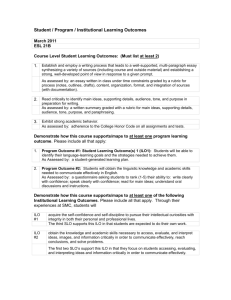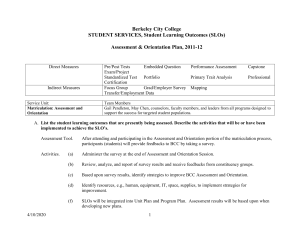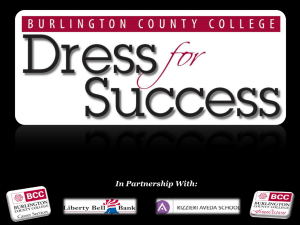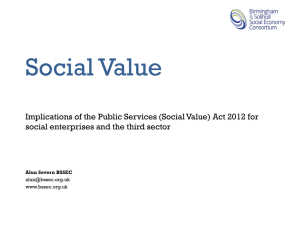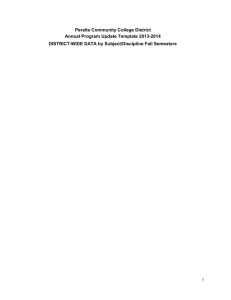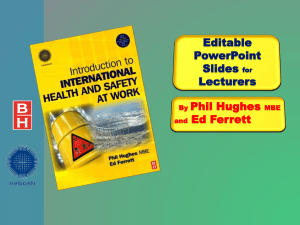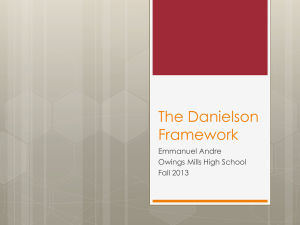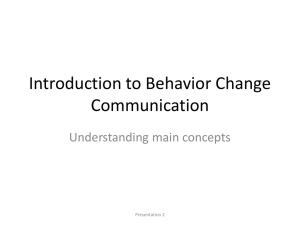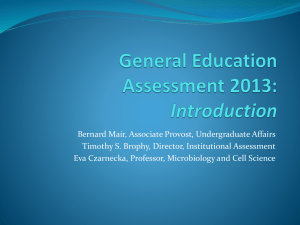The BCC Assessment Committee Welcomes You
advertisement
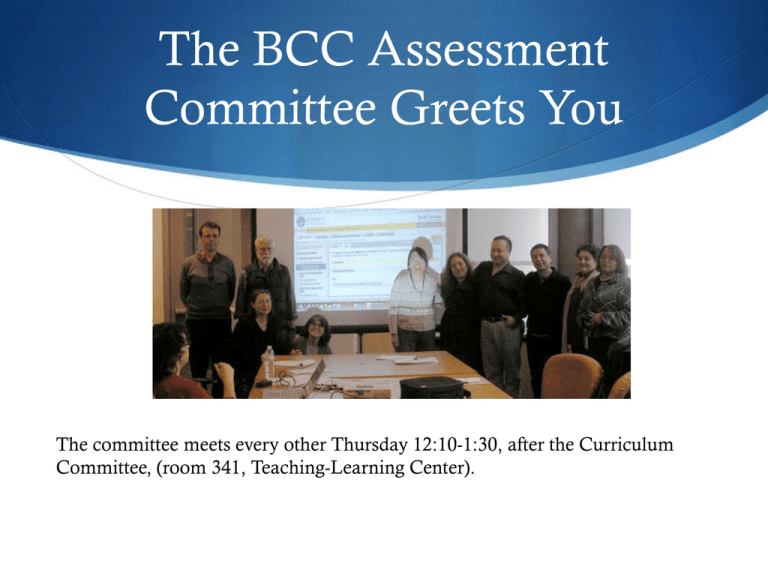
The BCC Assessment Committee Greets You The committee meets every other Thursday 12:10-1:30, after the Curriculum Committee, (room 341, Teaching-Learning Center). BCC Assessment Committee Jenny Lowood,English/ESL/Educ/LRNRE (Chair) Josh Boatright, Library Leonard Chung, Business/CIS Pieter deHaan, Sciences Matt Freeman, Social Sciences Iva Ikeda, ASL Willy Lizarraga, Modern Languages Sabrina Nelson, MMART Matthew Woods, Arts & Humanities Alley Young, Counseling, Student Services Dmitry Zhiv, Mathematics Linda Berry,VPI Denise Jennings, Title III Coordinator WASC SLO/Assessment Proficiency Requirements Course SLOs and Assessment Proficiency Requirement Our Response Faculty will complete SLOs for all courses and will assess them on an ongoing basis. 100% of all courses at BCC have SLOs, which are assessed on an ongoing basis. Program SLOs and Assessment Proficiency Requirement Faculty will complete SLOs for all programs and will assess them on an ongoing basis. Our Response 100% of all programs at BCC have SLO’s, which are assessed on an ongoing basis. Student Support Outcomes & Assessment Proficiency Requirement Our Response SLOs will be completed for all “student learning and support activities”; these will be assessed on an ongoing basis. 100% of all student learning and support activities at BCC have SLOs; they are assessed on an ongoing basis. Institutional Learning Outcomes Assessment Proficiency Requirement The college will define and assess its institutional learning outcomes. Our Response The college has defined its seven primary institutional learning outcomes; these are assessed on a three-year cycle. Our Areas of Focus: 2012-13 Looking to the Future ☛“Closing the Loop” ☛ Program Review ☛ ILO Assessment: Three-Year Cycle Begins The Assessment Cycle Closing the Loop Institutional Learning Outcomes (ILO) Assessment BCC’s Institutional Learning Outcomes • Communication • Critical Thinking • Ethics and Personal Responsibility • Global Awareness & Valuing Diversity • Information Competency • Quantitative Reasoning • Self-Awareness & Interpersonal Skills BCC’s Assessment Timeline Based on ILO’s Program Assessment Course Assessment Student Services Assessment Semester 1 Communication Semester 2 Critical Thinking Semester 3 Quantitative Reasoning Spring 2012 – Fall 2012 ASL AA (capstone) English AA’s/c’s English basic skills (courses) ESL (courses) MMART (capst) Spanish (capst) All courses with communication ILO Spring 2013 Fall 2013 (LRC) Semester 4 Ethics/Pers. Resp./ Self-Awareness/ Interpersonal Spring 2014 Semester 5 Global Awareness Semester 6 Information Competency Fall 2014 Spring 2015 Biotechnology AS/certs. Sciences Math AA Math basic skills CIS AS, certs. Art AA’s/cert’s PUB/HUSV PERSIST LRNRE (basic skills) Psychology AA Global Studies AA Sociology AA Liberal Arts (cumulative), social sciences/ humanities PACE (caps) Business AA/C’s Women’s Studies All courses with critical thinking ILO All courses with quantitative reasoning ILO All courses with ethics/pers.resp/ self-awareness/ interpersonal ILO Counseling LRC Student Ambass. All courses with global awareness ILO All courses with information competency ILO LRC Library High Impact Courses and Services Some high impact courses and service areas will be assessed every semester: ☛ English 1A ☛ English 5 ☛ Math 13 These courses fulfill key general education requirements and are taken by large numbers of students. ☛ Most student services areas will be assessed every year. Assessing the First ILO: The Communication Rubric Benchmark Milestone Developing Milestone Intermediate Capstone Context of and Purpose for Writing, including Audience Awareness Presentation demonstrates minimal attention to context, audience, purpose, and the assigned tasks(s) (expectation of instructor or self as audience). Presentation demonstrates beginning awareness of context, audience, purpose, and assigned tasks(s). Presentation demonstrates adequate consideration of context, audience, and purpose, and clear focus on the assigned task(s). Presentation demonstrates thorough understanding of context, audience, and purpose that is responsive to the assigned task(s) and focuses all elements of work. Organization Organizational pattern (specific introduction and conclusion, sequenced material within the body, and transitions) is not observable within the presentation. Organizational pattern (specific introduction and conclusion, sequenced material within the body, transitions) is intermittently observable within the presentation. Organizational pattern (specific introduction and conclusion, sequenced material within the body, and transitions) is clearly and consistently observable within the presentation. Organizational pattern (specific introduction and conclusion, sequenced material within the body, transitions) is clearly and consistently observable and skillful and makes the content of the presentation cohesive. Language Language choices are unclear and minimally support the effectiveness of the presentation. Language in presentation is not appropriate to audience. Language choices are mundane and commonplace and partially support the effectiveness of the presentation. Language in presentation is appropriate to audience. Language choices are thoughtful and generally support the effectiveness of the presentation. Language in presentation is appropriate to audience. Language choices are imaginative, memorable, and compelling, and enhance the effectiveness of the presentation. Language in presentation is appropriate to audience. Levels/Criter ia Note: This rubric was culled from the AACU Value Rubrics for Written Communication and Oral Communication (value@aacu.org). Assessing the First ILO: Strategies We focused on assessing how well students are achieving the communication ILO in courses that are “mapped” to communication: ☛ We applied the rubric to 256 randomly chosen essays from fourteen classes in eight different disciplines (Art, Business, English, History, HLTED, HUSV, Music, and Political Science); they represented five different departments. ☛ Each essay was read and scored by two different readers and the scores compared; discrepancies were resolved by a third reader. ☛ The scorers were from across the college: ☛ 1 from Business ☛ 2 from English ☛ 2 from History ☛ 1 from HUSV ☛ 1 from MMART Written Communication Assessment Results BCC Spring 2012 60% 57% 50% 43% 39% 40% 30% 20% 10% 0% purpose organization language Percentages of students earning a grade of 6 (acceptable) – 8 (strong). Does English 1A Make a Difference? The chart below shows the scores of students who were identified as having taken English 1A, as opposed to those who did not identify whether they had taken English 1A. purpose organization language COM/ENGL 1A YES 77% 58% 65% COM/ENGL 1A ? 51% 34% 37% Variability Among Courses In several courses, students demonstrated much higher proficiency in writing than in others. COM/BUS 10 COM/OVERALL purpose 85% 57% organization 92% 39% language 38% 43% COM/HIST 7B COM/OVERALL purpose 80% 57% organization 60% 39% language 90% 43% Action Plan – Communication ILO Assessment ☛ The instructors of the “high scoring” classes (not in the English department) developed a packet on how to design a writing prompt or assignment and rubric for grading. ☛ The packet will be shared with the college and we will conduct an assessment of essays written in those classes in which the packet is used. Program Assessment: An Overview What Are BCC’s programs? BCC’s Assessment Committee, Curriculum Committee, Roundtable & Department Chairs’ Council have agreed that BCC programs are as follows: ☛Degrees and certificate programs (including general education) ☛Interdisciplinary programs, like PACE (including general education) ☛Basic skills ☛All programs in Student Services ☛Any other departments, as self-identified Program Assessment ☛ Program assessments follow the same steps as course assessments. ☛ Program matrices help to show the relationships among institutional learning outcomes, program outcomes, and course outcomes. A Sample Program Matrix Program Assessment: An Example Assessing The Writing Program– Step 1 Identification of Student Learning Outcomes (SLO’s) ☛ write well organized, well developed, effective, well edited, logically sound, and clear essays ☛ write effective, well edited, well organized research papers of 3,000-5,000 words which apply appropriate and clear organizational strategies ☛ apply active reading strategies in order to identify main ideas and critically analyze and explain ideas in texts Assessing The Writing Program – Step 2 Assessment Plan ☛ All students in English 1A, English 201AB, English 269AB, ESL Writing 5, and ESL Writing 6 submit a portfolio consisting of a 45 page research paper, an essay written in class, and a reflective essay. ☛ All portfolios are scored by two English instructors, based on a departmentally designed rubric; the raters do not know the students’ names or class levels; scores are compared and discrepancies resolved by a third reader. ☛ The department reviews the results and recommends plans for improvement. Assessing The Writing Program– Step 3 Analysis of Findings (Part 1) Assessing The Writing Program – Step 4 Analysis of Findings (Part 2) ☛ English 1A students performed satisfactorily in the areas of clarity/style, organization, explanations/evidence, reading, and mechanics (more than 67% received scores of 3 and above in these areas). ☛ English 1A students did not perform as well in the areas of critical thinking (59%) and research techniques (46%). ☛ Writing 6 students performed well in all areas except clarity/style, and mechanics. ☛ 40% of English 269 students performed as well as students receiving a grade of B or A in English 201. Assessing The Writing Program– Step 5 Changes in College Planning (Closing the Loop) ☛ Collaboratively develop open resource materials on research, which will be available for all students in the writing program ☛ Develop “accelerated” class for students who test into English 269, which has the same curriculum as English 201 but provides additional support, based on the writing workshop model ☛ Change curriculum for English 1A and English 201AB to allow for more practice in research skills ☛ Improve placement exam or other measures of incoming students to improve placement into English 269 and 201 Assessing The Writing Program– Step 6 Assessing Effects of Changes 100.00% 90.00% 80.00% 70.00% 60.00% 50.00% Engl. 1A Sp 11 Engl. 1A Sp 12 40.00% 30.00% 20.00% 10.00% 0.00% Rdg Comp. Orgn Dev./ Illus. Text. Evid. Analysis Clarity/ Style Mech. /Usage MLA form. #Qual/ Sources Implementing Action Plans Across the College – Some Examples ☛ We’ve developed an accelerated basic skills English course, as well as new resources, a new curriculum, and an English composition “model schedule” for English 1A, 201, and 248UX. ☛ We revamped our MMART certificate sequence. ☛ We used assessment findings in the redesign of our ESL curriculum. ☛ We added hours in the library and made other changes in student services areas. ☛ We changed curriculum in Spanish, Business, and many other departments. Thank you! Any questions?
